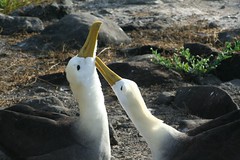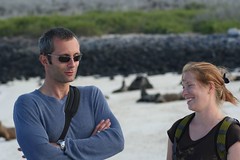
Click on picture for slide-show (167 pics!)
or here to access the first set.
I won’t try to tell you how beautiful, amazing, fascinating or (insert superlative adjective of your choice) those islands are; I will let the pictures speak for themselves instead. They may not want to speak out loud either because during most of our cruise the sky was covered with clouds, which didn’t make my camera happy at all. However, the 300mm lens helped a lot with the wildlife. There isn’t really a need for such powerful zoom except for close-ups; in most places the animals are so close you can touch them - which, of course, you shouldn’t and neither should you feed them the crackers that you brought with you to snack upon.

Click on picture for slide-show (148 pics!)
or here to access the second set.
There are a few daily flights to the islands from Quito and Guayaquil, and people pour in by the hundreds (or should I say thousands?) into the airport built by the Americans in the 40s on Baltra island. The first thing one does after leaving the tarmac is to reach for the wallet and pay the $100 park entrance fee. I don’t know what happens with this money but I hope it goes to a good cause. Next you find your guide (assuming you booked a tour, which is what most people do, unless they decided to hunt for last-minute deals in Puerto Ayora), and meet the rest of the group you will share the boat with for the next 5 or 8 days, depending on your tour package. You check out the faces of people waiting for their luggage and pray that whoever it is, they not be too annoying, stuck-up, boring, too old, or speak no English...

Click on picture for slide-show (121 pics!)
or here to access the third set.
Life on board is as easy as you make it… and as comfortable as you paid for. The only difference between the various classes of boats is what you get on board; the wildlife doesn’t know the luxury cruise passenger paid a thousand dollars more than the hippies on the economy boat. We chose a “tourist superior” class schooner which offered great comfort for its size. The cabins were small but they all had private bathrooms with hot water. The food was great and there was enough of it, three times a day, including desert with lunch and dinner; I don’t think I have had such a regular meal schedule since I was 6 years old and living with my parents (no, I wasn’t in the army). There were only 12 passengers, which is a good group size; you can get to know them all, and if somebody is annoying or awkward to talk to, you can always switch places at the table for the next meal. As antisocial as I am, I didn’t get to hate anybody; I spoke Italian with an older Italian couple, there were two German guys which helped me practice the rusty remains of my German, and I tried my Spanish with the crew. Everybody else was from English-speaking countries… except for the British couple Lisa and Matthew – I didn’t understand a word they were saying. We became friends with Mor (that’s a girl name, in Israel) and Michael, and we may see them again in Cuzco and Buenos Aires since they are following a route similar to ours.
Our guide, Juan, was an ageless-looking forty-something black guy, spoke decent English using lots of infinitive verbs, and had a peculiar sense of humor. He liked to repeat things: “sea lions, sea lions, sea lions” or “boobies, boobies, boobies” (the birds, that is) and sometimes gave short moralizing lectures about the ravages that homo sapiens would perpetrate on “his” islands if the park authority (and himself as a representative) wouldn’t protect them.
And protected they are, indeed. There is a limited number of tour-boat licenses (a hundred from what I gathered), which effectively limits the number of tourists that disembark each day on the islands. Getting new licenses may be possible if you have lots of money and friends high up in the government but it doesn’t seem to be the norm. The routes of the boats are also regulated by the park authority to prevent too many boats from anchoring in a place at the same time. The park also sets the times when tour groups from various boats can land on the islands in an effort to prevent overcrowding of trails and to avoid stressing the wild life, which one day may not be so eager to share the same habitat with the humans and may run away at their approach. The number of people in a visiting group is limited to 16 and trail paths are also marked and must be respected – not that most people who visit Galapagos would want to steal albatross eggs from their nests - the dangers here are erosion and carelessness. These practices seem to be bearing fruit - the islands are clean (no coca-cola bottles or cigarette butts anywhere), we’ve rarely seen more than one other group on the same trail with us and the animals still ignore you when you get close to them.
We did a few dives and a lot of snorkeling as well, and while the underwater scenery wasn’t too impressive, it was interesting nonetheless. There is no coral reef in the Galapagos (at least not at the sites we visited) so the bottom of the ocean isn’t of much interest. There were many fish down there of course, but no huge schools like we were expecting. The highlights were always the manta rays, the sting rays, the moray eels and… the sharks and we saw quite a few of them. Of course, the sharks were small and were minding their own business; otherwise I don’t think we would have been getting close to look at them with excitement; we would have done quite the opposite, if I may say so…
If I had discovered Galapagos when I was younger I would have certainly dreamed of a different career path: the joke of the day on the boat had been revolving around the new “hot” profession, the goat killer. The islands, it seems, have a large numbers of species introduced accidentally by the humans, one of them being the goat. These creatures are such pests that no other species can compete with them for food, surely not the slow giant tortoises and the iguanas. Goats devour all plant life and have the reproducing capabilities of a copying machine. Besides, in a bizarre twist which serves only to prove Darwin’s theory of evolution, they have adapted their bodies to drink salt water. Lest the last of the endemic wildlife die of hunger, the government started a goat-eradication program some years ago and has successfully eliminated the quadruped on most islands, bullet by bullet, goat by goat. It seems to be a well paid job, although it must be quite exasperating to have to keep aiming at pairs of horns for eight hours a day. Do you think these guys have a “bring your daughter to work” day?






5 comments:
Oh, man - I thought you'd guys had gotten yourselves kidnapped.
wow, amazing, that was really nice.
when/how did u purchase the ticket for the flight to Galapagos, it is hard to get one and get in the park?
mitru
Dein Deutsch ist noch aktzeptabel :-)
poliglotule din Gradini Manastur :-)
mitru
Cool!
PS: How does the albatross taste? :)
Lemo.
Mitru
It's not hard to get to the islands but it's not cheap either. We purchased the tickets from a tourism agency in Quito a couple of months before we left. You can only get into the park with an organized tour on a boat.
Lemo
Dunno, couldn't catch one. But I guess it would taste like chicken, wouldn't it?
Post a Comment